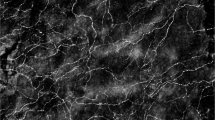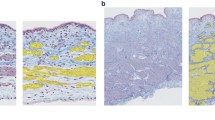Summary
Necturus urinary bladders were mounted in a two-compartment chamber filled with Ringer's solution and individual cells were punctured with microelectrodes from the serosal surface. By measuring the changes of transepithelial resistance and potential in response to luminal application of amiloride, and measuring the effects of amiloride on the voltage divider ratio and on the serosal cell membrane potential, two independent methods were obtained to calculate the cell membrane resistances and the resistance of the shunt path. The results from both methods agreed favourably. Th mucosal and serosal membrane resistances were found to vary respectively from 9–65 kΩ cm2 and from 1–7 kΩ cm2 under control conditions. Significant correlations were observed between the luminal membrane resistance as well as the luminal membrane zero current potential and the short circuit current, which indicate that the luminal membrane conductance consists predominantly of Na+-selective elements, whose density varies from bladder to bladder and determines the rate of transpithelial Na+ transport. Amiloride which blocks these elements increased the luminal resistance to 220 kΩ cm2. Increasing short circuit current was also correlated with increasing conductance of the serosal membrane (at fairly constant zero current potential) which points to an electrogenic mechanism of active Na+ transport across the serosal cell surface. The paracellular shunt path across the terminal bars plays a minor role in urinary bladder epithelium. Its resistance was estimated to be in the range of 50–125 kΩ cm2 or greater.
Similar content being viewed by others
References
Boulpacp, E.: Electrophysiological properties of proximal tubule: Importance of cellular and intracellular transport pathways. In: Electrophysiology of Epithelial Cells. (G. Giebisch, ed.), pp. 91–112. Stuttgart: Schattauer 1971
Civan, M. M., Hoffman, R. E.: Effect of aldosterone on electrical resistance of toad bladder. Am. J. Physiol.220, 324–328 (1971)
Erlij, D.: Basic electrical properties of tight epithelia determined with a simple method. Pflügers Arch.364, 91–93 (1976)
Frizzell, R., Schultz, S. G.: Ionic conductances of extracellular shunt pathway in rabbit ileum. J. Gen. Physiol.59, 318–346 (1972)
Frömter, E.: The route of passive ion movement through the epithelium of Necturus gallbladder. J. Membr. Biol.8, 259–301 (1972)
Frömter, E.: Stofftransport durch biologische Membranen. In: Biophysik. Ein Lehrbuch (W. Hoppe, W. Lohmann, H. Markl, H. Ziegler, eds.), S. 328–361. Berlin-Heidelberg-New York: Springer 1977
Gruber, W. D., Knauf, H., Frömter, E.: The action of aldosterone on Na+- and K+-transport in the rat submaxillary main duct. Pflügers Arch.344, 33–49 (1973)
Higgins, J. T., Jr., Cesaro, L., Gebler, B., Frömter, E.: Electrical properties of amphibian urinary bladder epithelia. I. Inverse relationship between potential difference and resistance in tightly mounted preparations. Pflügers Arch.358, 41–56 (1975)
Higgins, J. T., Jr., Gebler, B., Frömter, E.: Electrical properties of amphibian urinary bladder epithelia. II. The cell potential profile in Necturus maculosus. Pflügers Arch.371, 87–97 (1977)
Leaf, A.: Transepithelial transport and its hormonal control in the toad bladder. Ergebn. Physiol.56, 216–263 (1965)
Lewis, S. A., Eaton, D. C., Diamond, J. M.: The mechanism of Na+ transport by rabbit urinary bladder. J. Membr. Biol.28, 41–70 (1976)
Lindemann, B.: Impalement artifacts in microelectrode recordings of epithelial membrane potentials. Biophys. J.15, 1161–1164 (1975)
Reuss, L., Finn, A. L.: Passive electrical properties of toad urinary bladder epithelium. J. Gen. Physiol.64, 1–25 (1974)
Reuss, L., Finn, A. L.: Dependence of serosal membrane potential on mucosal membrane potential in toad urinary bladder. Biophys. J.15, 71–75 (1975)
Reuss, L., Finn, A. L.: Electrical properties of the cellular transepithelial pathway in Necturus gallbladder. J. Membr. Biol.25, 115–139 (1975)
Spooner, P. M., Edelman, I. S.: Further studies on the effect of aldosterone on electrical resistance of toad bladder. Biochim. Biophys. Acta406, 304–314 (1975)
Ussing, H. H.: The alkali metal ions in isolated systems and tissues. In: Handbuch der Experimentellen Pharmakologie, (O. Eichler and A. Farah, eds.), pp. 1–195. Berlin-Göttingen-Heidelberg: Springer 1960
Author information
Authors and Affiliations
Rights and permissions
About this article
Cite this article
Frömter, E., Gebler, B. Electrical properties of amphibian urinary bladder epithelia. Pflugers Arch. 371, 99–108 (1977). https://doi.org/10.1007/BF00580777
Received:
Issue Date:
DOI: https://doi.org/10.1007/BF00580777




